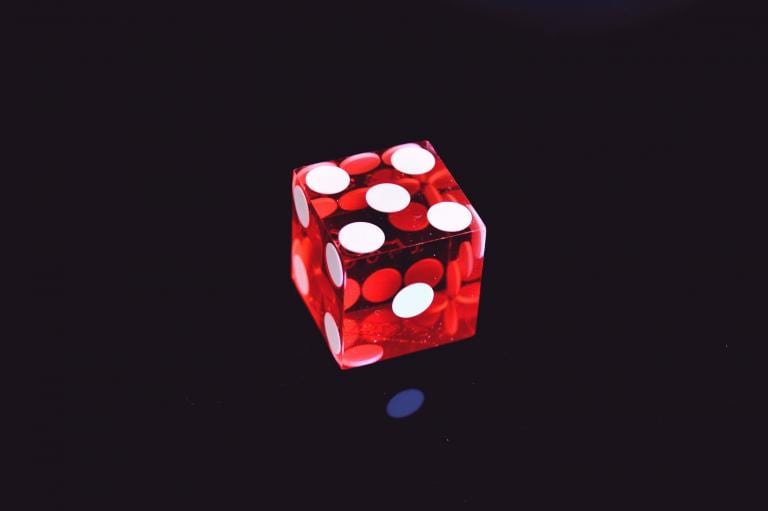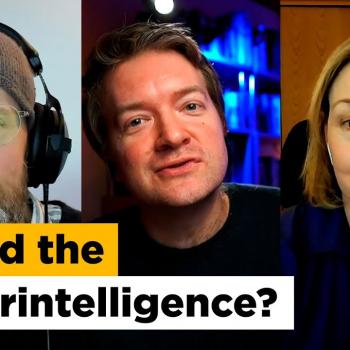 Four years ago we released a cheekily-titled video on fine-tuning called ‘How a dice can show that God exists’. I never imagined the response it would generate from people all over the world. It currently has over 2 million views and over 36,000 comments on YouTube – some positive… some not so much!
Four years ago we released a cheekily-titled video on fine-tuning called ‘How a dice can show that God exists’. I never imagined the response it would generate from people all over the world. It currently has over 2 million views and over 36,000 comments on YouTube – some positive… some not so much!
Years later, I still think it holds true: a dice can show that God exists (and yes, I know, it should be ‘die’ but that always sounded weird to me). The dice wasn’t really the subject of the video of course. It was a prop for an argument about why the fine-tuning of the universe suggests there is a cosmic mind behind it all.
As much as there have been a lot of snarky comments about the video, there have also been many positive responses. One Christian memorably wrote to tell me that the video had ‘changed his life’. He had been experiencing doubts about his faith, but the video had helped him to see things afresh. He now leaves dice around his home and even went as far as to get a tattoo of dice on his wrists, as a reminder that he didn’t get here by accident. His life has a purpose.
The fact is, by scientific standards, this universe and our human existence within it is incredibly improbable. Here’s why…
Fine Tuning
One of the early revelations I experienced on Unbelievable? when hosting discussions between scientists was learning about the existence of the ‘fine tuning’ of our universe for life. Advances in cosmological science over the latter half of the twentieth century began to reveal that, when the universe began, the fundamental forces it was birthed with were apparently ‘fine-tuned’ to allow for the emergence of life.
Some 30 or so fundamental numbers, such as the force of gravity and the ratio of electrons to proton mass in the universe, are so exquisitely balanced that the tiniest fluctuation from their actual value would mean that a universe capable of producing life could simply not exist.
So, did we just get lucky? To answer that question, we have to try to get our heads around the numbers we are talking about. The odds of the finely tuned universe we live in coming about by chance are so unlikely that it’s difficult to conceive of the astronomically large numbers involved.
Gravity
In the video I focus on the expansion rate of the universe, but I could have chosen any one of the various constants and quantities in question. Take the force of gravity. We’re all reasonably familiar with the effects of gravity – it’s the force that keeps our feet stuck to the earth, the same one that purportedly caused a falling apple to collide with Isaac Newton’s head. Yet gravity is a curious sort of force.
First, it’s very weak. Every atom in the universe exerts a gravitational pull on every other atom in the universe, but the strength of the force from an individual atom is extremely small. You may not feel that’s the case when you trip up and land in a heap on the pavement, but that’s only because you are feeling the combined force of every atom in the world below you pulling on your body.
Second, although scientists can describe the effects of this force in amazing detail, enabling them to accurately predict the motions of the planets hundreds of years into the future, no scientist really knows what gravity actually is. How and why does it emanate from every object of any mass in the universe? It’s a mystery. And here’s another question: why does it take the very specific tiny value that it does?
This second question is what’s at stake when it comes to fine tuning. Gravity acts as a universal superglue. It holds together planets, solar systems and galaxies. Were the force of gravity ever so slightly weaker than it is, the glue would become too weak and no objects of any sort would be able to form. The universe would be a place where matter was distributed thinly across the entire cosmos, with no stars, planets or galaxies present for life to have a chance of developing on.
If the force was ever so slightly stronger than it is, the glue would become too strong, and the universe would soon have collapsed back in on itself. The result again: no life. So, just how finely tuned is the force of gravity? How much wiggle room is there?
Science tells us that if it differed from its value by one part in 1060 then the universe as we know it would be unable to exist. For those unfamiliar with the scientific notation of numbers, 1060 is a ‘1’ with 60 zeros after it. Written down numerically it would come out as 1 000,000,000,000,000,000,000,000,000,000,000,000,000,000,000,000,000,000,000,000. Or written out in words: one trillion trillion trillion trillion trillion. That’s a very large number, and therefore a very tiny window within which the force of gravity could differ from its actual value and still produce a life-permitting universe.
There’s nothing about the force of gravity that suggests it had to be what it is – it could potentially have taken an entirely different value. So, what are the chances of hitting that tiny life-permitting value by accident? How lucky would you have to be?
Using a familiar way of looking at chance and odds may help. For my sake as much as yours, I’m going to try to keep the maths simple.

The Cosmic Dice
Imagine you have a regular six-sided dice in your hand. Mathematically, if you roll the dice the chance of a 6 coming up is 1 in 6. That’s not too bad. But what are the chances of rolling 6 twice in a row? Well, the odds get longer – it’s 1 in 6 multiplied by 1 in 6; that’s 1 in 36. So, you’d have to be rather lucky to get two 6s in a row. Every time you add the chances of rolling another 6 in a row, the odds go up exponentially and it gets even more unlikely.
So, what if you rolled your dice 80 times and every single time you got a 6? That’s quite unlikely, but it’s possible…right? In fact, the chances of rolling a 6 80 times in a row are around 1 in 1060, the same amount of wiggle room that the force of gravity has.
Just to put that in perspective: how long would you have to stand there rolling your dice for (allowing about 5 seconds per roll) before hitting a lucky streak and rolling eighty 6s in a row? I’ll spare you yet another very long number, but on average you would have to stand there rolling your dice for trillions upon trillions upon trillions of years before hitting that winning streak of 80 throws of the number 6. That’s a long time.
By comparison, our universe has only been around for a relatively paltry 14 billion years. Perhaps this helps us to see how vastly unlikely it is that the life-permitting value for the force of gravity could have been hit upon by chance. And that’s only one of numerous finely tuned fundamental forces that our universe is dependent upon, many of them even more exquisitely balanced.
Building Blocks and the Eiffel Tower
Perhaps the most impressive example of fine tuning is the initial low entropy distribution of mass and energy in the early universe necessary for life. “What is that?” you may ask. Here’s my attempt at a boiled-down explanation:
My youngest child Toby enjoys playing with a large tub of wooden building blocks. More specifically, he enjoys knocking over the carefully constructed towers I create for him. When we get the blocks out, he likes me to pick up the tub and pour them on to the floor. Whenever I do it, the blocks spread out in an untidy heap. The way the blocks are organized in the tub before I pour them out, as well as other factors such as the angle I tip them out, the surface they land on and the density of the air, determine what sort of heap will be created – sometimes it’s a bit more of a pointy heap and sometimes they scatter more widely. But it’s always a disorganized heap.
However, it’s theoretically possible that there is some arrangement of blocks in the tub which, when poured out in the right way, after tumbling and colliding, would end up neatly stacking into a miniature replica of the Eiffel Tower. My 5-year-old son would be delighted to knock it over as soon as possible, but I would be flabbergasted. What are the chances of that?
In a far more precise way, in the earliest moments of our universe, all matter and energy was organized in an incredibly dense but very specific way, before it was flung out far and wide as the universe began its expansion. The vast majority of the ways that the matter could have been first organized would have produced a universe full of black holes, completely hostile to the possibility of life developing at any point in its future.
That’s the equivalent of the disorganized heap of blocks that falls out of my tub, every time. But, as it happens, the arrangement of the matter in the early universe was set up to go down the Eiffel Tower route. It was precisely arranged so that it distributed itself in a way that meant only a relatively small number of black holes could exist, allowing stars, galaxies and planets to form, and the opportunity for life to occur at some point.
Fine Tuning
The fine tuning required for the universe to have this characteristic is an incomprehensible 1 part in 1010(123). When Robin Collins, a philosopher of science, appeared on Unbelievable? he described the nature of that number by saying:
“If you took a sheet of paper and filled it with zeros, then reproduced zeros on sheets of paper lined up across the entire universe, 15 billion light years across, that number would still be smaller than 1010(123).”
Others have remarked that if you wrote a ‘1’ and then placed a zero on every single fundamental particle in the entire universe, you would still be a long way short of the length of the number in question.
That the various physical forces and initial conditions of our universe are incredibly finely tuned to allow the formation of chemistry, stars, planets, galaxies and ultimately life to come into existence, is a fact rarely contested by physicists. The physicist Paul Davies, who is himself an agnostic, has said:
“There is now broad agreement among physicists and cosmologists that the universe is in several respects ‘fine-tuned’ for life.”
Astronomer Fred Hoyle, despite his atheism, famously wrote:
“A common-sense interpretation of the facts suggests that a superintellect has monkeyed with physics, as well as with chemistry and biology, and that there are no blind forces worth speaking about in nature.”
Chance or trickery?
The question that remains is: why are things this way? Philosophers such as William Lane Craig have pointed out that there appear to be just three possible explanations: chance, physical necessity or design.
Chance seems to be ruled out by the probabilities involved. Physical necessity seems to be ruled out by the fact that there is no obvious reason why the forces and initial conditions could not have taken very different values. That only leaves design.
Let’s return to those trillions of years of dice rolling. If you sat down in front of a friend and rolled the number 6 eighty times in a row, it’s highly unlikely they’d say “Well done – what a stroke of luck!” They’d think you had loaded the dice, or tricked them in some way.
We should apply the same logic to the fine tuning of the universe. Someone’s loaded the dice of gravity; someone clever has pre-organized the tub of blocks. There’s a mind behind the whole show that intended for us to be here. God.
Responding to objections
I know this video and argument won’t convince everyone. And there have been plenty of responses in the past few years.
Many in the YouTube comments (while I was still following them!) took issue with the dice analogy itself. After all, when it comes to probabilities, any set of eighty rolls of the dice are just as improbable as rolling eighty 6s in a row.
This was hardly a revelation to me of course. The whole point of my dice analogy is that, if you can only win a particular gamble by throwing eighty 6s rather than any other combination, then your chances of winning are infinitesimally small. It is the specificity of the eighty rolls, and likewise the specificity of the values of the fine-tuning of the universe that is at stake. If life can only develop within a very specific range of values, and those values happen to prevail, it still needs explaining.
There have also been plenty of other objections that typically get asked of fine tuning: Douglas Adams’ ‘puddle’ analogy, the size of the cosmos compared to our tiny planet, and of course the looming question of whether a multiverse could solve all of this. On that note, I’m happy to admit that I overstated things when I said that ‘there’s no scientific evidence’ for a multiverse in the original video (though I still think there are very good reasons why we are not in fact part of an potentially infinite number of universes). Likewise, I believe there are good responses to all of these objections and I try to address them in the ‘science’ chapter of my book Unbelievable? why, after ten years of talking with atheists, I’m still a Christian.
One particular response video by atheist You-tuber Cosmic Skeptic (aka Alex O’Connor) proved especially popular. Alex’s tone may have been a bit snarky, but he was gracious enough to accept an invitation to come on my show to debate the argument with Josh Parikh, another young Oxford University student. Alex and I have become friends in the years since, and I’ve appeared on his podcast too, which is another happy outcome of this video. Of course, Alex remains unconvinced, as do many others, and that’s fine. I’m used to people weighing the same evidence in different ways to me.
A cumulative case
Of course, in case it needs to be said, my Christian faith is not dependent on the validity of this specific argument or any other. For me, cosmic fine tuning (along with other aspects of our universe that seem to point beyond itself) is part of a cumulative argument for Christianity. Other evidences could also be called upon: Our sense that objective moral facts exist and that concepts like beauty, truth, love, consciousness and reason require something more than materialism to make sense. Ontological, teleological, and sociological arguments. Then there’s the historical evidence for the death and resurrection of Jesus. Nor is it only objective intellectual arguments that convince me, but also my subjective personal experience of finding myself experiencing forgiveness and new life through Jesus Christ. It’s the hardest thing for me to deny but the most difficult thing to prove to someone else.
But, love it or hate it, the dice video has proved an unexpected conversation starter and, four years later, is still going strong. Perhaps it’s time to present another theistic argument with an easy-to-grasp analogy on an cheekily-titled video, and see what happens…
Subscribe to the Unbelievable? podcast












